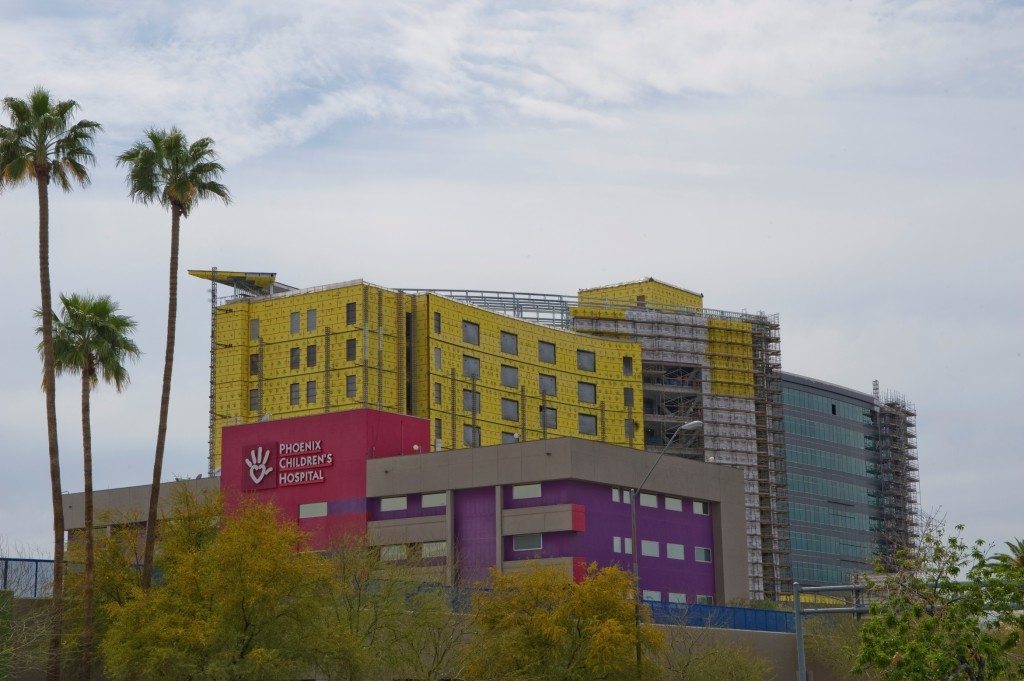Two major forces in the Valley’s health care industry are joining together to ensure the future of quality pediatric care in Arizona. St Joseph’s Hospital and Medical Center and Phoenix Children’s Hospital are in the process of negotiating a strategic alliance that will make Arizona a medical destination for young patients with complex and acute health care needs.
“Phoenix is the fifth-largest city in the country and it deserves to have a children’s hospital that is top tier in the country with the same breadth of programs, depth of resources and reputational scores for quality as children’s hospitals in other major markets,” says Robert Meyer, president and CEO of Phoenix Children’s Hospital (PCH).
Under the proposed alliance, St. Joseph’s will transfer a substantial portion of its pediatric service line to PCH. The collaboration will result in a full-service pediatric hospital, bringing together the best both hospitals have to offer. If an alliance is reached, much of the two hospitals’ pediatric medical staff, nurses and other staff will be united by mid-2011. At that time, the construction on PCH’s new 11-story hospital tower is expected to be complete, making Phoenix home to the second largest children’s hospital in the nation.
Under a current, non-binding memorandum of understanding, St. Joseph’s would continue to operate its neonatal intensive care unit and treat pediatric patients in its trauma unit, as well as patients age 15 and older. In addition, St. Joseph’s would be a minority member of Phoenix Children’s, with limited representation on PCH’s board of directors.
“When we brought our strengths to the table we became a tremendous force in the care of kids in this country,” says Linda Hunt, service area president of Catholic Healthcare West Arizona and president of St. Joseph’s Hospital & Medical Center. “We have leaders in pediatric care, advocacy and research that we can bring together to make this incredible force and improve kids’ care in the Southwest.”
Along with creating a powerhouse pediatric hospital, the shifting of services will enable St. Joseph’s to fulfill its strategic plan to become a destination hospital for patients from across the nation and around the world. To that end, Hunt says St. Joseph’s is expanding specialty programs such as neurosurgery, neurology, cardiology and pulmonology.
The two entities already have collaborated on specific programs, including physician cross-coverage for the Children’s Heart Center and a National Institute of Health grant that’s part of PCH’s Heart Center, housed at the Barrow Neurological Institute at St. Joseph’s. In spite of the various joint programs, no large-scale alliance had ever been attempted. PCH initially approached St. Joseph’s about a wider-ranging alliance, and the timing proved to be just right. Due to state budget issues, capacity constraints St. Joseph’s is facing, and the expansion already underway at PCH, the collaboration seemed like the natural progression.
“When I approached Linda Hunt in 2008 about revisiting a formal collaboration, we agreed to discard the baggage of failed collaborations of the past and brought fresh thinking to the discussion,” Meyer says. “What we found is that we are more alike than different. We share a common vision and very similar values. We are equally committed to excellent medical care, (and) both need to grow.”
The challenges facing these two health care leaders are daunting. Phoenix is one of the fastest-growing regions in the nation, and medical centers and hospitals must be prepared to face a large influx of young patients in the future. However, with both noted hospitals banding together, incredible progress can be made.
“By combining our pediatric programs, we can achieve a level that would be on par with the leading children’s hospitals in the country more quickly and efficiently than doing so alone,” Meyer says.
Among other things, the alliance will improve access to higher quality pediatric health care services in a cost-effective manner, enhance recruitment and resources for services and programs, accelerate the development of research programs, maintain and improve medical services for the under-served and more, Meyer adds.
The process of finalizing the proposed alliance is ongoing. At this time, presentations outlining the plans for the alliance have been made to physicians and staff at both hospitals. In addition, feedback programs have been created to field any questions or concerns employees may have. The process of assembling work groups with representatives from both hospitals participating in the integration plans also has begun.
“We believe this strategic alliance with CHW/St. Joseph’s will enable us to achieve our bold vision to be recognized as a national leader in pediatric health care,” Meyer says. “This community benefits from the strength of two of the leading providers of children’s medical care, because we’re better together than alone.”
www.phoenixchildrens.com | www.stjosephs-phx.org




